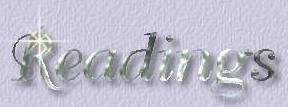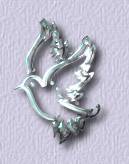

2 Kings 5:1-3, 9-14 The
cleansing of Naaman
Now
Naaman was commander of the army of the king of Aram. He
was a great man in the sight of his master and highly
regarded, because through him the Lord had given victory
to Aram. He was a valiant soldier; but he had leprosy.
Now
bands from Aram had gone out and had taken captive a young
girl from Israel, and she served Naaman's wife. She said
to her mistress, "If only my master would see the
prophet who is in Samaria! He would cure him of his
leprosy." . . .
So
Naaman went with his horses and chariots and stopped at
the door of Elisha's house. Elisha sent a messenger to say
to him, "Go, wash yourself seven times in the Jordan,
and your flesh will be restored and you will be
cleansed."
But
Naaman went away angry and said, "I thought that he
would surely come out to me and stand and call on the name
of the Lord his God, wave his hand over the spot and cure
me of my leprosy. Are not Abana and Pharpar, the rivers of
Damascus, better than any of the waters of Israel?
Couldn't I wash in them and be cleansed?" So he
turned and went off in a rage.
Naaman's
servants went to him and said, "My father, if the
prophet had told you to do some great thing, would you not
have done it? How much more, then, when he tells you,
'Wash and be cleansed'?" So he went down and dipped
himself in the Jordan seven times, as the man of God had
told him, and his flesh was restored and became clean like
that of a young boy.

Mark
1:4, 5, 9-15 The
baptism of Jesus
John
came, baptizing in the desert region and preaching a
baptism of repentance for the forgiveness of sins. The
whole Judean countryside and all the people of Jerusalem
went out to him. Confessing their sins, they were baptized
by him in the Jordan River. . . .
At
that time Jesus came from Nazareth in Galilee and was
baptized by John in the Jordan. As Jesus was coming up out
of the water, he saw heaven opened, and the Spirit
descending on him like a dove. And a voice came from
heaven: "You are my Son, whom I love; with you I am
well pleased."
At
once the Spirit sent him out into the desert, and he was
in the desert for forty days, being tempted by Satan. He
was with the wild animals, and angels attended him.
After
John was put in prison, Jesus went into Galilee,
proclaiming the good news of God. "The time has
come," he said. "The kingdom of God is near.
Repent and believe the good news!"

Arcana
Coelestia #4255.5 Washing
in the Jordan
The
cure of Naaman's leprosy, accomplished by washing himself
seven times in the Jordan according to Elisha's command,
represented baptism. Baptism means introduction into the
church and into the things that relate to the church, and
so into rebirth and the things that relate to rebirth.
Not
that we are reborn by baptism. Rather, baptism is a symbol
of rebirth, which we should remember. And because the
things that make the church are meant by baptism, and
baptism is meant by "the Jordan," it was the
Jordan in which people were baptized by John; and the
Lord, too, wanted to be baptized by John in the Jordan.


At
that time Jesus came from Nazareth in Galilee and was
baptized by John in the Jordan. As Jesus was coming up out
of the water, he saw heaven opened, and the Spirit
descending on him like a dove. (Mark 1:9, 10)
Today,
as we continue following Series 2 of the Bible Study
Notes by Anita Dole along with the Sunday School, we
come to the beginning of the Gospel of Mark. For the next
two months we will look at the life and ministry of Jesus
as told in the shortest--and probably the first
written--of the Gospels.
To
a secular reader, the Gospel story amounts to a biography
of a charismatic religious figure, exaggerated and
embellished by his followers so that a mere mortal is
presented as someone miraculous and divine. For people who
do not believe in God and spirit, there could be no virgin
birth, no healings, no miracles, and, of course, no
resurrection from the dead. All of these are either
wishful thinking or outright lies introduced by the Gospel
writers. And Jesus is simply a man who was misrepresented
by his followers--or, if his sayings are accurately
reported, a man who had delusions of grandeur and a flair
for hyperbole.
For
Christians, the Gospel story is so much more. It is the
story of the Son of God, the Word made flesh, God with us.
For Swedenborgians in particular, it is the story of how
God came to live among us as a divinely human being,
sharing our joys and our struggles, teaching us how to
live spiritually, and overcoming all the evil forces that
would destroy our souls. It is the story of the Creator
God coming personally to the ones he created to save us
from all the evils of selfishness and materialism with
which we had ensnared ourselves.
At
the same time, the story of the Lord Jesus is our own
story. Why? Because when God came to earth as Jesus, he
lived a life that is the ultimate pattern for our more
limited, merely human lives. And through the knowledge of
the deeper meanings in the Bible, we find that all the
events in the Lord's life tell us the story of what we go
through as we are reborn and re-created as loving, wise,
and spiritual human beings.
This
morning, as we begin the Gospel of Mark, we are also
beginning our own spiritual journey.
And
it all starts in the desert. This is exactly where we are
within ourselves before we make our decision to accept God
into our lives and live spiritually instead of
materialistically. However rich our outward life may be,
without God and spirit in our lives, we are inwardly as
empty and barren as the desert.
As
it turns out, Patty and I just got back from a trip out to
Arizona, where we spent a lot of time hiking in the
desert. In some ways, the desert has gotten a bad rap.
When we think of the desert, we tend to think of vast
expanses of sand with little or nothing growing there, and
only the occasional oasis to break up the nothingness. And
there are some stretches of desert like that.
But
what we saw in Arizona was very different. There was life
everywhere--a rich ecosystem with plants and animals
intricately designed to survive and even thrive in arid
land that receives less than ten inches of rain a year.
While we were in Arizona, a fairly large fraction of the
average nine inches of annual rainfall for the area was
coming down. So we saw the desert in bloom, with a
profusion of wildflowers all around us. And it was very
beautiful.
Yet
it was also very forbidding. Just about everything that
grows in the desert has spines or thorns or some other
defenses to help it cling to life in an environment where
only the hardiest plants and animals can survive. Unlike
the profuse, fast-growing greenery of temperate, tropical,
and rainy areas of the earth, where life thrives on sheer
abundance, the plants and animals of the desert are
adapted to conditions where life-giving water must be
carefully conserved, and where growth is generally slow
and deliberate. Modern humans are able to live in the
desert mainly by drilling for water deep under the
surface, or piping it in from distant rivers.
Spiritually,
the desert gives us a picture of human life in which the
water of spiritual truth is a scarce commodity, and we
cling to the edge of emotional survival on the scantiest
fare. Before our inner, spiritual self is opened to the
Lord's presence in our lives, we are often covered with
emotional thorns and spines in order to protect ourselves
from the "big bad world" out there. Though we
have growth and even beauty in our lives, there is
something lacking. We are lacking the abundant, spiritual
water of the Lord's refreshing truth.
And
what a wonderful thing that the very first event in Jesus'
ministry as told in Mark's Gospel is his baptism by John
in the Jordan! Coming from the desert, we find life-giving
spiritual water that washes and refreshes our souls.
To
understand the meaning of the Jordan and John's baptism,
let's look back for a moment to some of the Bible stories
we studied earlier about the children of Israel after they
had been rescued from slavery in Egypt. After leaving
Egypt, the Israelites spent forty years wandering in the
desert before finally reaching the Holy Land. These were
difficult, trying times, full of hunger and thirst,
enemies and battles, grumbling and complaining. We have
all had our times of wandering in the desert. Often they
are times when we do not feel close to God and heaven;
when we are focusing mostly on our own life in this world,
forgetting or forsaking our inner, spiritual life.
Eventually,
we get to the point where we have had enough of the
desert. We've struggled with thirst and thorns and barren
feelings long enough. And then, at last, we turn to the
Lord, looking for the new life that we have been promised
in the Bible. And then we are finally ready to enter the
promised land.
When
the children of Israel were at last ready to enter the
rich and fertile land that had been promised to them, what
did they have to cross over in order to get there? The
Jordan river! The miraculous crossing of the Jordan on dry
land was their introduction into the holy Land of
Canaan--which symbolizes a new, spiritually-oriented life.
And so the Jordan river represents our first introduction
into spiritual, God-centered life. And since water is a
universal symbol of truth, the Jordan river especially
symbolizes the deeper truth that first introduces us to
spiritual life.
Each
one of us who has turned our lives over to God has
experienced these basic, life-giving truths that transform
our thinking so that we are no longer living for material
pleasures and personal power, but for the love of God and
our neighbor.
Most
of these truths are so simple that a child can understand
them. For example, if we had previously been living mostly
for our own pleasure, perhaps what turned our lives around
was taking seriously such teachings of the Lord as
"do to others what you would have them do to
you" (Matthew 7:12); "Love your neighbor as
yourself" (Matthew 22:39); and "Seek first God's
kingdom and his righteousness, and all these things will
be given to you as well" (Matthew 6:33). These are
just a few of the simple, basic spiritual truths that can
introduce us into deeper and more fulfilling life if we
will take them to heart and follow them.
 This
is the true meaning of baptism. Our ritual of baptism is
intended to symbolize for us the deeper, spiritual washing
that happens when we accept the Lord and allow God's truth
to flow into our minds and hearts. This truth cleanses us
from all the unclean, unworthy thoughts and feelings that
cause us to wander in an emotional and spiritual desert
when we could be living in the rich and fertile land of
mutual love and understanding. And though the Lord Jesus
had never sinned--as we do whenever we intentionally do
things we know are wrong--he wished to be baptized in
order to show us by example that we must be inwardly
washed clean if we wish to have true, abundant spiritual
life. This
is the true meaning of baptism. Our ritual of baptism is
intended to symbolize for us the deeper, spiritual washing
that happens when we accept the Lord and allow God's truth
to flow into our minds and hearts. This truth cleanses us
from all the unclean, unworthy thoughts and feelings that
cause us to wander in an emotional and spiritual desert
when we could be living in the rich and fertile land of
mutual love and understanding. And though the Lord Jesus
had never sinned--as we do whenever we intentionally do
things we know are wrong--he wished to be baptized in
order to show us by example that we must be inwardly
washed clean if we wish to have true, abundant spiritual
life.
The
story of Naaman the Syrian, understood spiritually, gives
a beautiful picture of the cleansing powers of the Jordan
river. Naaman was a great, powerful, and famous person.
And yet, he suffered with leprosy, a debilitating skin
disease that was considered degrading in his culture.
This
is how our lives are when we are living for the world and
for our own purposes instead of for the Lord. We may
accomplish great things in this world; we may acquire many
beautiful things and experience many pleasures; we may
even be looked up to by the people around us. But we will
not gain any deep and lasting satisfaction from all of
this. Instead, our outward life--symbolized by the skin,
which is the outermost part of our body--will give us less
and less satisfaction. We will feel plagued by desires
that we can never fulfill, and nothing will bring us
relief. Though we may hide our sense of malaise from
everyone around us, we ourselves will know that our life
is getting worse and worse. We are inwardly sick even when
the world considers us to be a great success.
The
healing of this condition comes from the same Jordan river
in which John baptized the people of Judea, and also
Jesus. But we are usually not ready to receive that
baptism and healing right away. Especially if we've spent
a lot of time and energy building up a good life for
ourselves, and then tried all sorts of tricks and
therapies to make ourselves feel better when that
"good life" grows hollow, we will tend to resist
the Lord's way of healing us. We may hold out for some
great miracle to make us feel justified in going to all
that trouble and expense to fix ourselves by our own
strength.
But
the Lord's way is really very simple. A child can do it.
And as Naaman's servants told him, so can those who are
great in their own eyes--as we all too often are. If we,
like Naaman, are willing to set aside our pride and follow
those simple divine truths such as the Golden Rule and
loving our neighbor as ourselves, then our emotional and
spiritual malaise will be healed. We will find new life
rushing into us, giving new meaning and joy to our
everyday activities. If we will take the simple steps of
putting God first and showing as much consideration to
others as we would like them to show to us, we will find
healing for all of our broken feelings and broken
relationships.
All
of this, and much more, is contained in the simple story
of the Lord's baptism by John in the Jordan. And if we are
willing to take it to heart, we will be able to hear and
follow the first teaching given to us by Jesus after his
baptism and his temptation in the desert: "The time
has come," he said. "The kingdom of God is near.
Repent and believe the good news!" Next week, we will
consider how our hearing and heeding this message changes
both our inward and our outward lives, as we consider
Jesus' parable of putting new wine into new bottles. Amen.

|